Fine hair doesn’t mean you have to settle for flat, lifeless styles. The choppy bob has emerged as one of the most transformative haircuts for adding volume, texture, and movement to thin strands.
This guide explores over 30 of the best choppy bob haircuts for fine hair you’ll want to try this year, covering everything from styling techniques to maintenance tips.
Whether you’re looking for a dramatic change or a subtle refresh, choppy layers create the illusion of thicker, fuller hair while keeping your look modern and effortless.
You’ll discover how strategic cutting techniques, smart styling choices, and the right products can turn fine hair into a statement-making style that turns heads wherever you go.
Contents
- 1 1. What Makes Choppy Bob Haircuts Perfect for Fine Hair
- 2 2. Classic Choppy Bob with Textured Ends
- 3 3. Layered Choppy Bob for Maximum Volume
- 4 4. Asymmetrical Choppy Bob for Edge
- 5 5. Shaggy Choppy Bob with Bangs
- 6 6. Inverted Choppy Bob for Dramatic Shape
- 7 7. Choppy Bob with Undercut
- 8 8. Blunt Choppy Bob for a Modern Look
- 9 9. Wavy Choppy Bob for Texture Lovers
- 10 10. Choppy Bob with Balayage Color
- 11 11. Pixie-to-Bob Choppy Transition Cut
- 12 12. Choppy Bob with Face-Framing Layers
- 13 13. Tousled Choppy Bob for Effortless Style
- 14 14. Choppy Bob with Peek-a-Boo Highlights
- 15 15. Micro-Choppy Bob for Fine Hair
- 16 16. Razored Choppy Bob for Maximum Movement
- 17 17. Choppy Bob with Root Lift
- 18 18. Choppy Bob with Soft Waves
- 19 19. Choppy Bob with Textured Fringe
- 20 20. Messy Choppy Bob with Side Part
- 21 21. Choppy Bob for Naturally Wavy Hair
- 22 22. Choppy Bob with Blonde Ombré
- 23 23. Curly Choppy Bob for Volume
- 24 24. Choppy Bob with Money Pieces
- 25 25. Choppy Bob with Deep Side Sweep
- 26 26. Stacked Choppy Bob with Nape Detail
- 27 27. Choppy Bob with Highlights and Lowlights
- 28 28. Choppy Bob with Retro Vibes
- 29 29. Choppy Bob with Platinum Blonde
- 30 30. Choppy Bob with Subtle Balayage
- 31 31. Choppy Bob Styling Products Guide
- 32 32. Choppy Bob Maintenance and Care
- 33 Conclusion
1. What Makes Choppy Bob Haircuts Perfect for Fine Hair
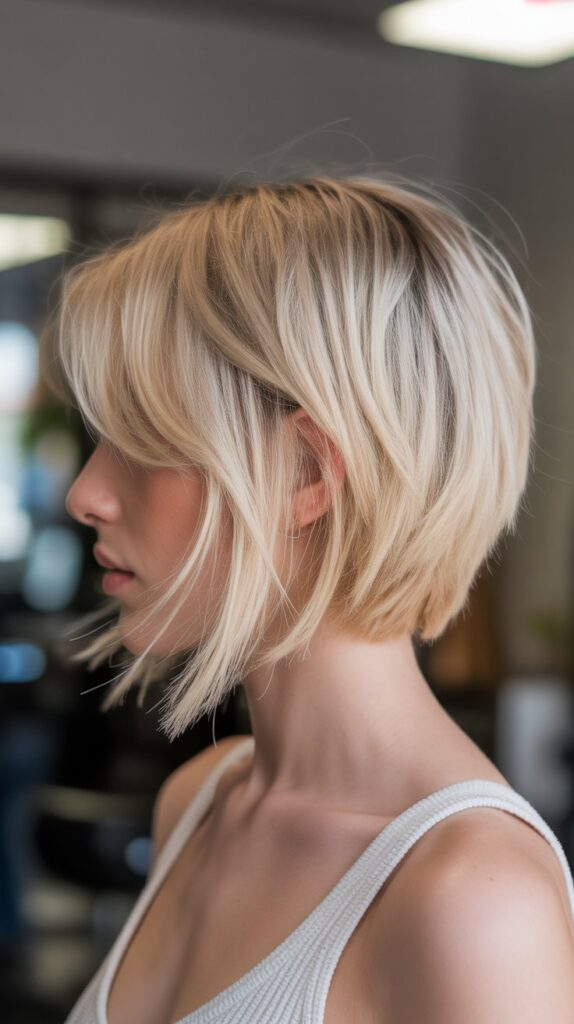
Choppy bob haircuts work exceptionally well for fine hair because they create dimension and movement that naturally lifts hair away from the scalp.
The textured, piece-y layers add visual weight and make strands appear fuller than they actually are.
Why Texture Matters
- Fine hair typically lies flat against the head, which can make it look thin and lifeless.
- Choppy layers disrupt the uniform pattern of hair, creating shadow and light that gives the appearance of density.
- The uneven lengths prevent hair from clumping together, which allows each section to move independently.
- This cutting technique removes weight from the ends while maintaining volume at the crown.
- The result is hair that appears to have more body and substance without requiring excessive styling.
The Science Behind the Cut
- Fine hair has a smaller diameter than medium or coarse hair, which means less protein structure in each strand.
- Traditional blunt cuts can emphasize the thinness by creating a straight line that shows exactly how much hair you have.
- Choppy layers create multiple endpoints at varying lengths, which makes it impossible for the eye to track where the hair truly ends.
- This optical illusion is enhanced when hair is styled with texture products that separate the pieces.
- The cutting angle used in choppy bobs also lifts hair at the roots, creating natural volume.
2. Classic Choppy Bob with Textured Ends
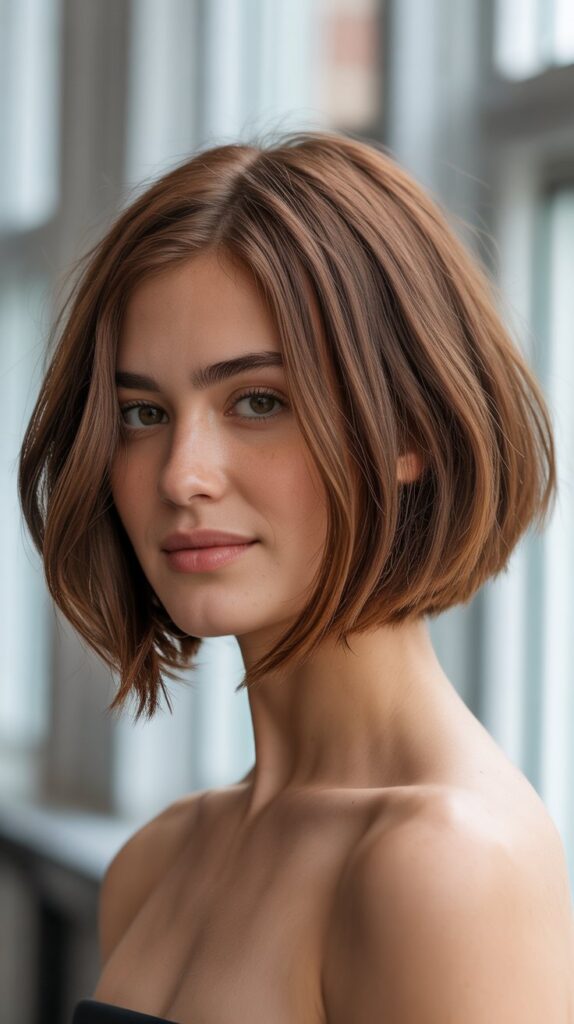
The classic choppy bob features hair cut to jaw or chin length with heavily textured ends that create a lived-in, effortless appearance.
This style serves as the foundation for many variations and works beautifully on fine hair by adding instant personality.
Cutting Technique Details
- The hair is typically cut to one length around chin level, creating a perimeter.
- Stylists then use point-cutting or razor techniques to texturize the ends, removing bulk.
- The interior layers are subtly graduated to prevent the top from looking too heavy.
- This creates a shape that’s fuller at the crown and lighter at the ends.
- The texturing should be concentrated in the bottom two inches for maximum effect.
Styling Recommendations
- Apply a volumizing mousse to damp hair, focusing on the roots.
- Blow-dry using a round brush, lifting at the roots to create lift.
- Use a flat iron or texturizing iron on the ends, creating piece-y separation.
- Finish with a dry texture spray or sea salt spray for enhanced definition.
- Avoid heavy oils or serums that can weigh down fine hair and make it look greasy.
3. Layered Choppy Bob for Maximum Volume
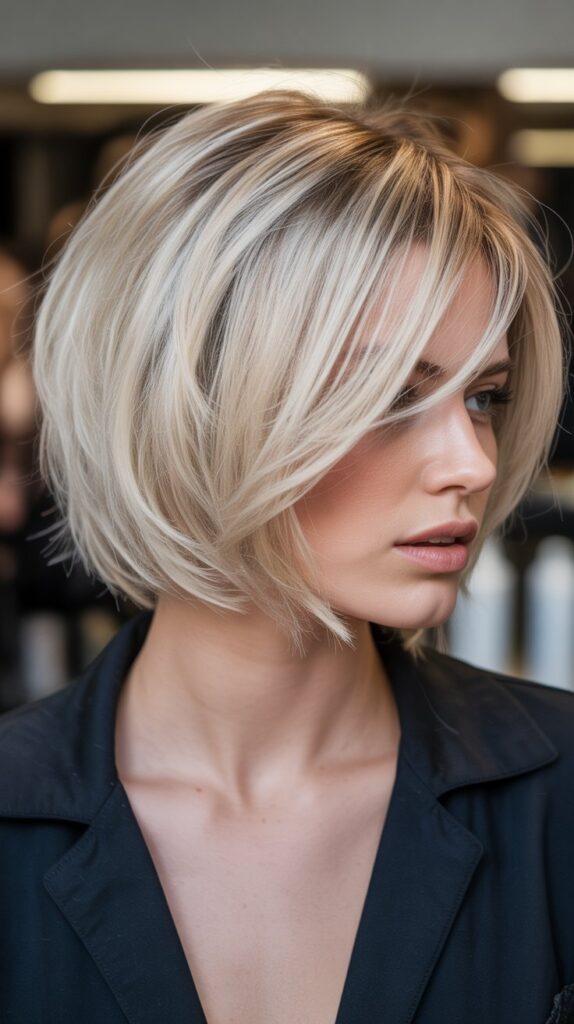
This variation incorporates multiple layers throughout the entire head, not just at the ends, creating maximum volume and movement.
The layered choppy bob is ideal for those with very fine hair who need extra body.
Layer Placement Strategy
- The first layer typically starts at the crown, about two to three inches from the scalp.
- Subsequent layers are placed every inch or so, creating a cascading effect.
- Each layer is point-cut or razor-cut to blend seamlessly with the next.
- The shortest layers frame the face while longer pieces fall in the back.
- This creates a rounded, voluminous silhouette that doesn’t look heavy or bulky.
Maintenance Requirements
- This cut requires trimming every four to six weeks to maintain the layered shape.
- The layers can grow out awkwardly if left too long between appointments.
- Regular deep conditioning treatments help prevent split ends on the textured pieces.
- Using heat protectant before styling is essential to maintain hair health.
- Consider asking your stylist to refresh the texture between full cuts to extend the style.
4. Asymmetrical Choppy Bob for Edge
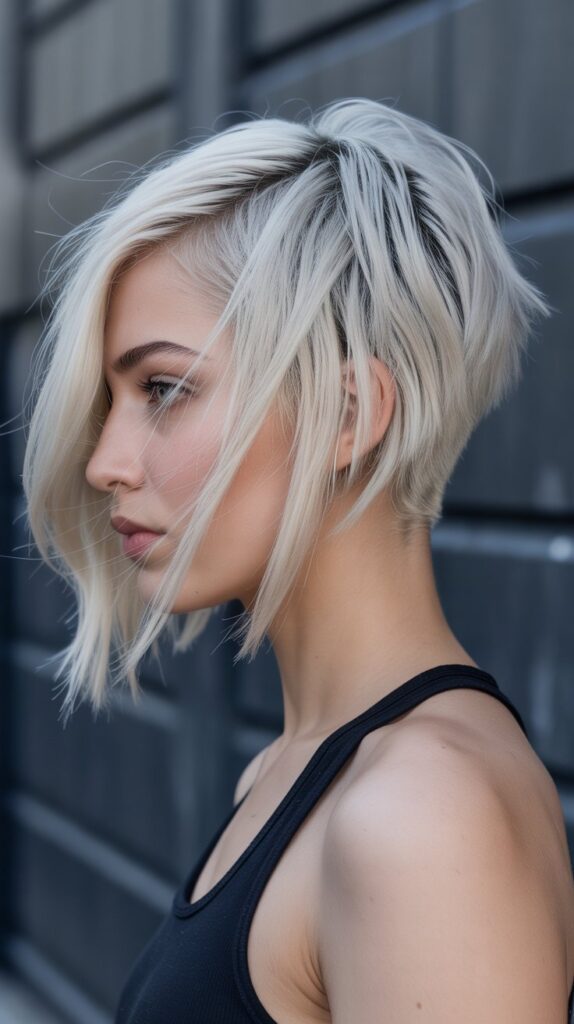
An asymmetrical choppy bob features one side cut noticeably longer than the other, creating a dramatic, fashion-forward look.
This style adds interest and can be customized to suit different face shapes.
Design Considerations
- The longer side typically ranges from chin to shoulder length.
- The shorter side can be anywhere from ear-length to pixie-short, depending on preference.
- The transition between lengths can be gradual or dramatic.
- Choppy texturing on both sides prevents the cut from looking too structured.
- This style works particularly well for oval and heart-shaped faces.
Styling Versatility
- The longer side can be tucked behind the ear for a completely different look.
- Styling the longer side with waves creates a romantic, feminine appearance.
- Wearing it straight emphasizes the geometric, architectural nature of the cut.
- The shorter side can be slicked back with gel for an edgier vibe.
- This cut allows you to change your look based on which side you part your hair.
5. Shaggy Choppy Bob with Bangs

Combining a choppy bob with bangs creates a retro-inspired look that’s currently trending in fashion circles.
The shaggy texture throughout adds a carefree, bohemian element to the style.
Bang Options for Fine Hair
- Curtain bangs are ideal for fine hair as they’re parted in the middle and frame the face without covering the forehead entirely.
- Wispy, piece-y bangs work better than thick, blunt bangs which can overwhelm fine hair.
- The bangs should be cut with the same choppy technique as the rest of the hair for consistency.
- Keeping bangs slightly longer prevents them from looking too heavy or childish.
- Baby bangs can work but require significant maintenance and confidence to pull off.
Creating the Shaggy Texture
- The shag element comes from varying the layer lengths more dramatically than in a standard layered bob.
- Shorter layers around the crown create lift and volume.
- Longer, piece-y layers throughout add movement and prevent the style from looking too polished.
- The ends should be heavily texturized with a razor or point-cutting technique.
- This creates a deliberately undone look that’s perfectly imperfect.
6. Inverted Choppy Bob for Dramatic Shape
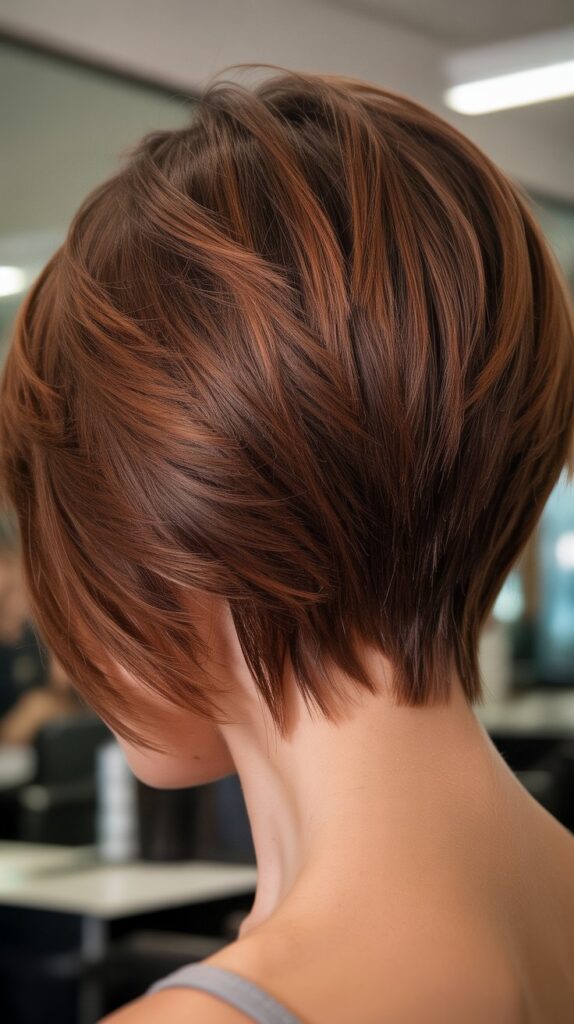
The inverted choppy bob is stacked in the back and longer in the front, creating a striking silhouette.
This cut adds volume at the crown while the choppy texture keeps it modern and wearable.
Structural Elements
- The back is cut shortest, often at or above the nape of the neck.
- The hair gradually lengthens as it moves toward the front, creating an angled perimeter.
- The difference between back and front length can range from subtle to extreme.
- Internal layering is concentrated in the back to create the stacked effect.
- The choppy texturing softens what would otherwise be a very structured, geometric cut.
Who Should Try This Style
- This cut works exceptionally well for those with naturally straight fine hair.
- It’s ideal for people with oval or heart-shaped faces.
- Those with shorter necks can benefit from the exposed neckline.
- If you have a round face, request longer front pieces to create lengthening lines.
- This style requires regular maintenance every three to four weeks to maintain the stacked shape.
7. Choppy Bob with Undercut

Adding an undercut to a choppy bob removes weight and creates a hidden element of surprise.
This style is perfect for those with very thick fine hair (lots of strands but each one is thin) who need bulk removed.
Undercut Placement Options
- A nape undercut is the most common, shaved or buzzed underneath the occipital bone.
- Side undercuts can be placed at the temples for a more visible statement.
- The undercut section can be shaved with clippers or scissors-cut very short.
- You can hide the undercut completely when hair is down or show it off in updos.
- This technique significantly reduces drying time and makes styling easier.
Styling and Growing Out
- The top layers need to be long enough to completely cover the undercut when desired.
- Regular maintenance every two to three weeks keeps the undercut looking fresh.
- Growing out an undercut requires patience as the grow-out phase can be awkward.
- Styling the longer top layers with texture helps blend the undercut as it grows.
- This is a commitment style that works best for those willing to maintain it regularly.
8. Blunt Choppy Bob for a Modern Look
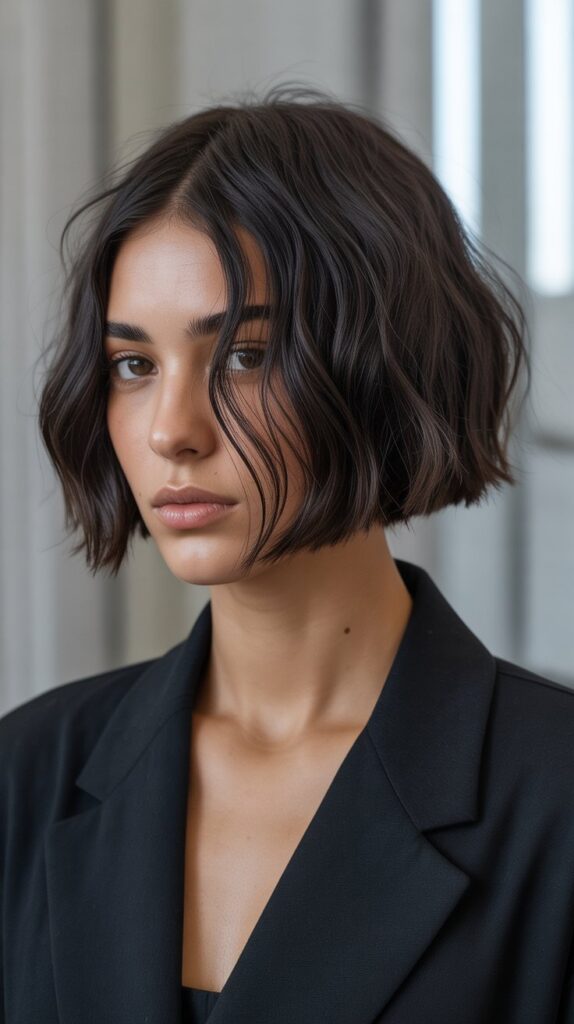
While this may seem contradictory, a blunt choppy bob combines a strong horizontal line with textured ends.
The result is a contemporary, high-fashion look that works surprisingly well on fine hair.
Balancing Blunt and Choppy
- The perimeter of the haircut is cut in a straight, precise line for dramatic effect.
- The ends are then heavily point-cut or razor-cut to add texture and movement.
- Internal layers are kept minimal to maintain the blunt appearance when styled straight.
- This creates a shape that’s both structured and lived-in simultaneously.
- The contrast between the clean line and textured ends is what makes this cut special.
Ideal Hair Types
- This works best on fine hair that’s naturally straight or only slightly wavy.
- Those with very curly or kinky fine hair may not achieve the desired look.
- The hair should be healthy without excessive split ends for the best result.
- This cut emphasizes the condition of your hair, so proper care is essential.
- Consider this style if you prefer a more polished, sophisticated appearance.
9. Wavy Choppy Bob for Texture Lovers
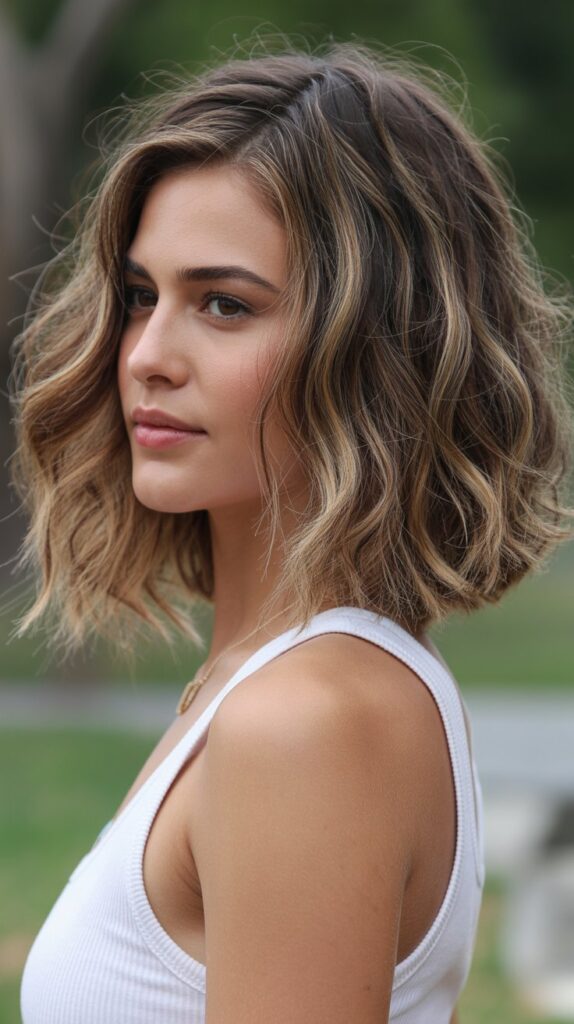
Enhancing a choppy bob with waves creates a romantic, dimensional look that maximizes the benefits of the layered cut.
The waves emphasize the choppy layers and create even more volume.
Creating Natural-Looking Waves
- Use a large-barrel curling iron or wand, taking vertical sections of hair.
- Alternate the direction of the curls (some toward face, some away) for natural variation.
- Don’t curl the ends; leave the last inch or two straight for that choppy effect.
- Finger-comb through the curls to break them up and create waves rather than ringlets.
- Set with a flexible-hold hairspray that allows movement.
Wave Maintenance for Fine Hair
- Avoid heavy curl creams that weigh down fine hair and make waves fall flat.
- A lightweight mousse applied before heat styling provides hold without heaviness.
- Sleeping on a silk pillowcase helps waves last longer between styling sessions.
- Refresh second-day waves with a dry texture spray and re-curling a few pieces.
- The choppy layers help waves hold better than in a one-length cut because of the varying weights.
10. Choppy Bob with Balayage Color
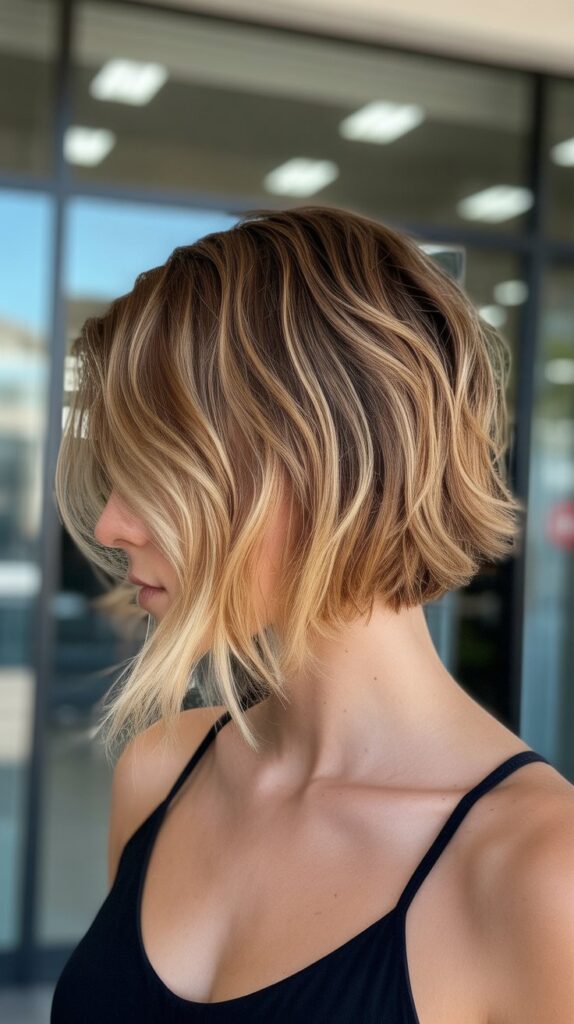
Combining a choppy bob with balayage coloring creates dimension that enhances the textured cut.
The painted-on highlights add depth and make fine hair appear even fuller.
Color Placement Strategies
- Concentrate lighter pieces around the face to brighten and frame your features.
- Place highlights on the top layers where light naturally hits the hair.
- Keep the underneath sections darker to create depth and shadow.
- The contrast between light and dark creates the illusion of more hair.
- Ask for a “lived-in” balayage that doesn’t require frequent touch-ups.
Maintenance Considerations
- Balayage requires less maintenance than traditional highlights since there’s no harsh line.
- Plan for color refresh appointments every eight to twelve weeks.
- Use color-safe, sulfate-free shampoo to preserve the tone and prevent fading.
- Purple shampoo helps maintain blonde tones and prevent brassiness in lighter colors.
- Deep conditioning treatments weekly help maintain hair health after coloring.
11. Pixie-to-Bob Choppy Transition Cut
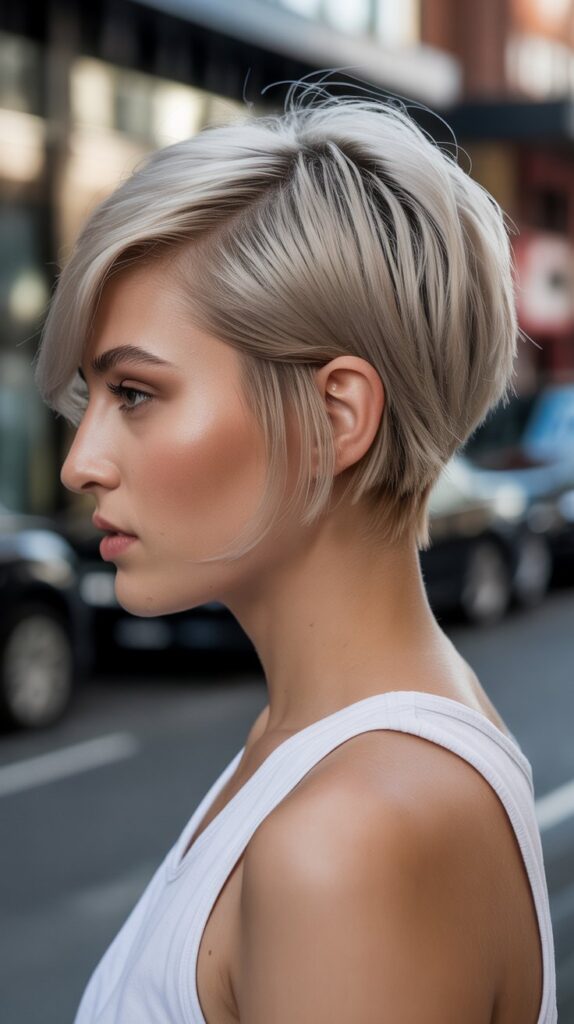
This style is perfect for those growing out a pixie cut, incorporating choppy layers to manage the awkward in-between lengths.
It creates a wearable, stylish look during the transition phase.
Managing Different Lengths
- The back and sides will be shorter, reminiscent of the pixie cut.
- The top and front sections are left longer to create movement and style options.
- Choppy texturing throughout helps blend the varying lengths.
- Regular trims every four weeks shape the cut as it grows.
- This phase typically lasts three to six months depending on your hair growth rate.
Styling During the Grow-Out
- Use a strong-hold pomade or wax to create piece-y, textured styles.
- A small flat iron can create flips and curves in the longer sections.
- Headbands and clips become functional styling tools during this phase.
- Embrace the edgy, undone look rather than fighting against the different lengths.
- The choppy texture makes the transition less obvious than growing out a blunt pixie.
12. Choppy Bob with Face-Framing Layers
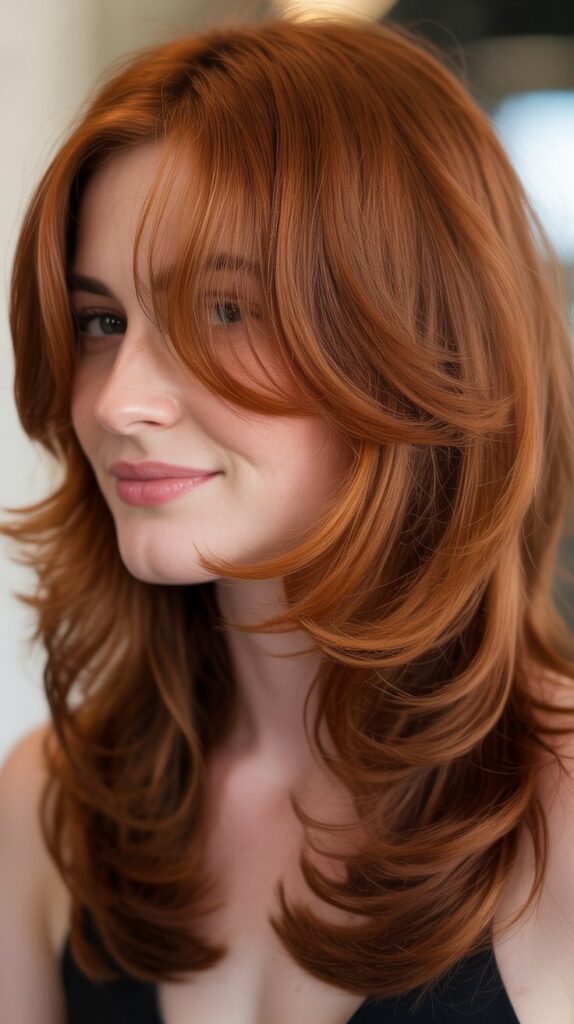
Face-framing layers are cut shorter around the face and gradually lengthen toward the back.
Combined with a choppy bob, they create a flattering, softening effect for all face shapes.
Strategic Layer Placement
- The shortest face-framing pieces typically start at the cheekbone or chin level.
- These layers are cut at an angle that slopes toward the back.
- The face-framing sections should be no more than an inch wide on each side.
- These layers draw the eye to your facial features and create a slimming effect.
- The choppy texture on these pieces creates movement that flatters as you move.
Face Shape Considerations
- Oval faces can handle any length of face-framing layers.
- Round faces benefit from longer layers that start at the chin to create length.
- Square faces look best with layers that start at the jaw to soften angular features.
- Heart-shaped faces need layers that add width at the jawline.
- Long faces should avoid layers that are too long, which can elongate further.
13. Tousled Choppy Bob for Effortless Style
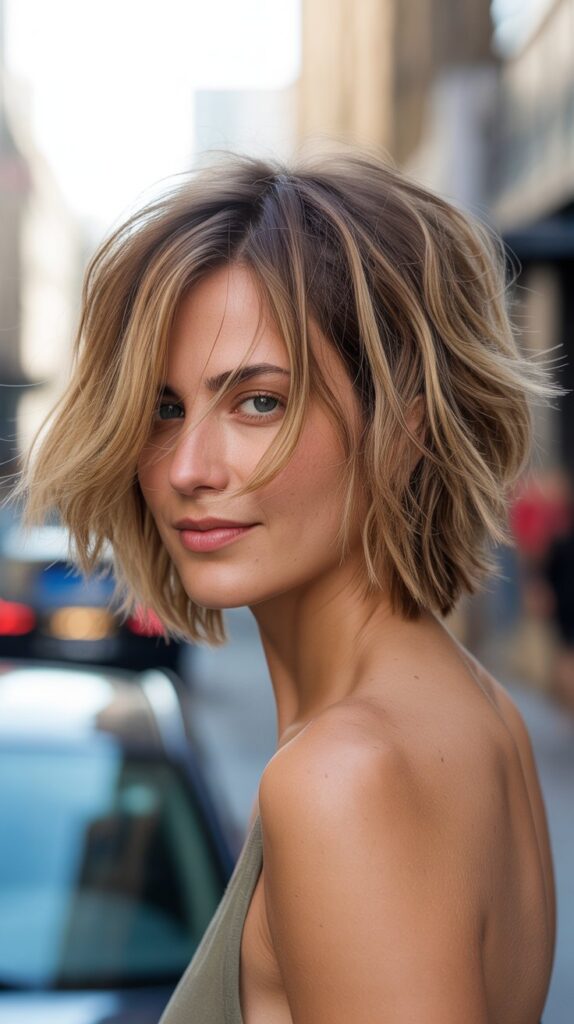
The tousled choppy bob embraces a messy, undone aesthetic that looks like you just rolled out of bed—in the best way possible.
This low-maintenance style is perfect for those with busy lifestyles.
Achieving the Tousled Look
- Start with damp hair and apply a sea salt spray throughout.
- Scrunch the hair as it air-dries or use a diffuser on low heat.
- Once dry, use your fingers to separate pieces and create texture.
- A small amount of dry texture paste adds definition without making hair crunchy.
- The goal is to look artfully disheveled, not unkempt.
Products That Work Best
- Sea salt spray provides grit and texture without weight.
- Dry texture spray adds volume and separation to finished styles.
- Lightweight texture paste or cream defines pieces without stiffness.
- Avoid mousses and gels that can make hair look too done or structured.
- A flexible-hold hairspray maintains the style while allowing movement.
14. Choppy Bob with Peek-a-Boo Highlights
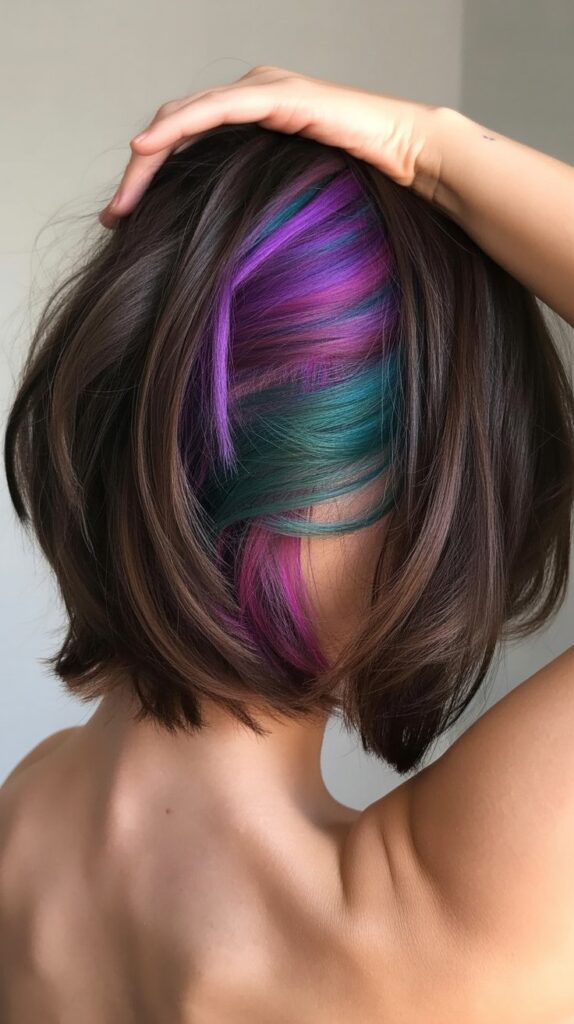
Peek-a-boo highlights are hidden underneath the top layers, revealing themselves with movement.
Combined with a choppy bob, they add an unexpected pop of color and dimension.
Color Placement Technique
- The highlights are placed in the underneath sections of hair.
- When hair is worn down, they’re mostly hidden with just glimpses showing through.
- When hair is styled up or tucked behind ears, the color becomes more visible.
- This technique allows for bold colors in a professional-appropriate way.
- The choppy layers help reveal the peek-a-boo color even when hair is down.
Popular Color Choices
- Vibrant fashion colors (purple, blue, pink) create dramatic contrast with natural bases.
- Metallic tones (rose gold, silver) offer a modern, subtle approach.
- Complementary natural tones (deep red under brown, platinum under blonde) add dimension.
- The color can be placed in just one section or throughout the underlayers.
- Consider your workplace and lifestyle when choosing how bold to go.
15. Micro-Choppy Bob for Fine Hair
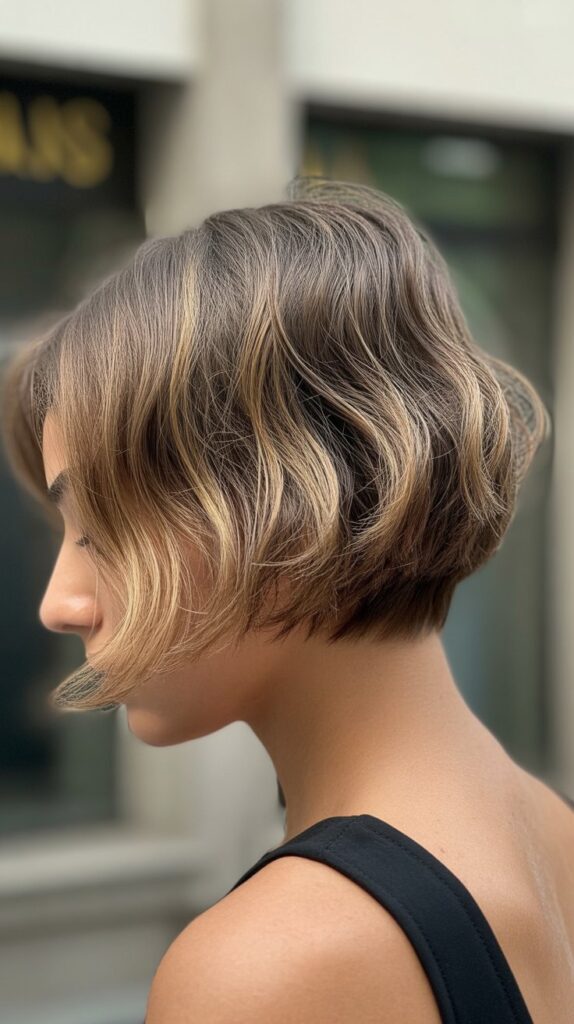
The micro-choppy bob features very small, subtle choppy layers throughout that create texture without obvious chunkiness.
This refined approach works beautifully for professional environments.
Subtle Texturizing Techniques
- The stylist uses point-cutting with scissors held nearly vertical to the hair.
- Small snips are made into the hair shaft rather than across it.
- This creates softness and movement without removing significant length.
- The technique is repeated throughout the entire cut for consistent texture.
- The result is refined and polished while still having dimension.
Professional Styling
- This cut can be styled straight with a paddle brush for a sleek look.
- Adding gentle waves creates soft, sophisticated movement.
- The micro texture allows for versatility between polished and casual looks.
- A lightweight shine serum enhances the refined appearance.
- This style works well in conservative professional environments.
16. Razored Choppy Bob for Maximum Movement
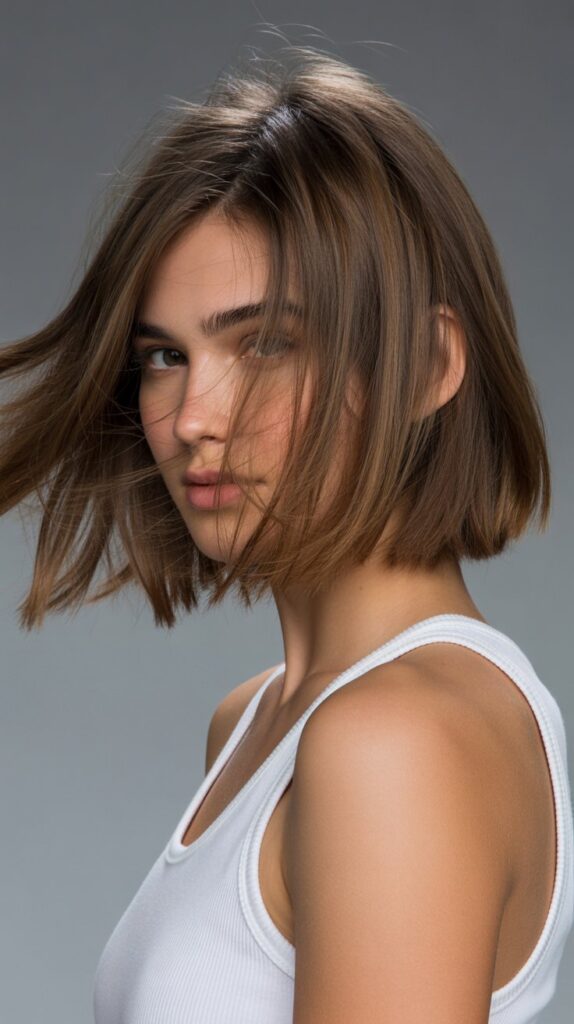
A razored choppy bob uses a razor instead of scissors to create the layers and texture.
This technique produces softer, more feathered ends with exceptional movement.
Razor Cutting Benefits
- The razor creates a softer, more diffused edge than scissors.
- Fine hair responds particularly well to razor cutting as it removes weight without creating harsh lines.
- The technique allows for greater control over the degree of texture.
- Razored edges blend more naturally with the rest of the hair.
- The result is hair that moves more fluidly and feels lighter.
Important Considerations
- Razor cutting requires a skilled stylist as improper technique can damage hair.
- The razor must be sharp to prevent split ends and ragged cuts.
- Hair should be cut damp (not soaking wet) for best results with a razor.
- This technique may not be suitable for very damaged or fragile fine hair.
- Ask your stylist if they’re comfortable with razor cutting before committing.
17. Choppy Bob with Root Lift
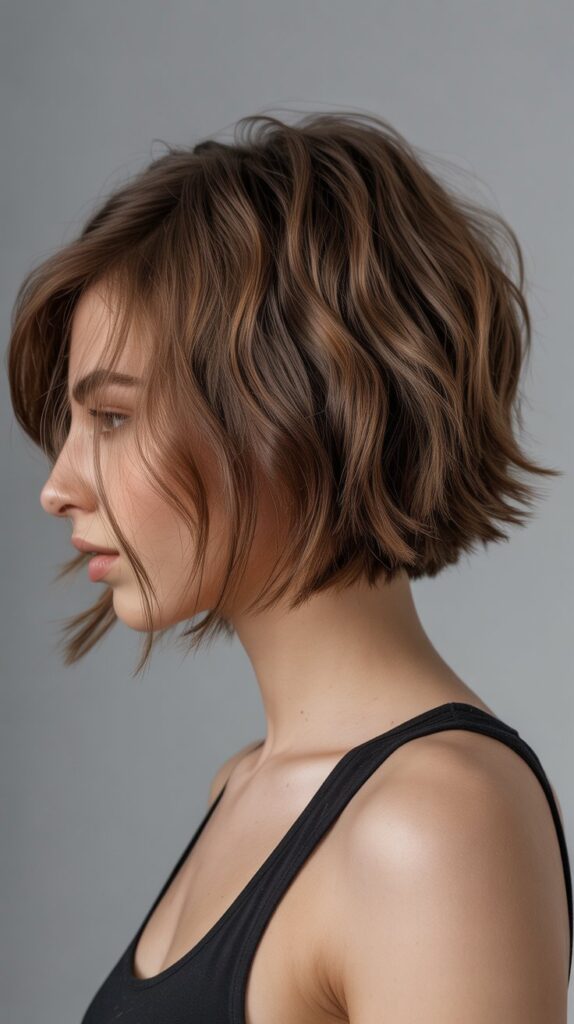
This styling approach focuses on creating volume at the roots while maintaining the choppy, textured ends.
The combination makes fine hair appear significantly fuller and more voluminous.
Root Lifting Techniques
- Apply volumizing mousse or spray to damp roots before drying.
- Use a round brush while blow-drying, lifting hair up and away from the scalp.
- Direct the blow dryer down the hair shaft from roots to ends to smooth the cuticle.
- Velcro rollers placed at the crown while hair cools can set in volume.
- A teasing brush at the roots adds extra lift for special occasions.
Products for Root Volume
- Volumizing mousses provide lift without weight when applied to damp hair.
- Root lifting sprays activate with heat styling for targeted volume.
- Dry volume powders can be sprinkled at the roots and massaged in after styling.
- Avoid applying conditioner to the roots, which weighs hair down.
- A volumizing shampoo prepares hair for styling by removing buildup.
18. Choppy Bob with Soft Waves
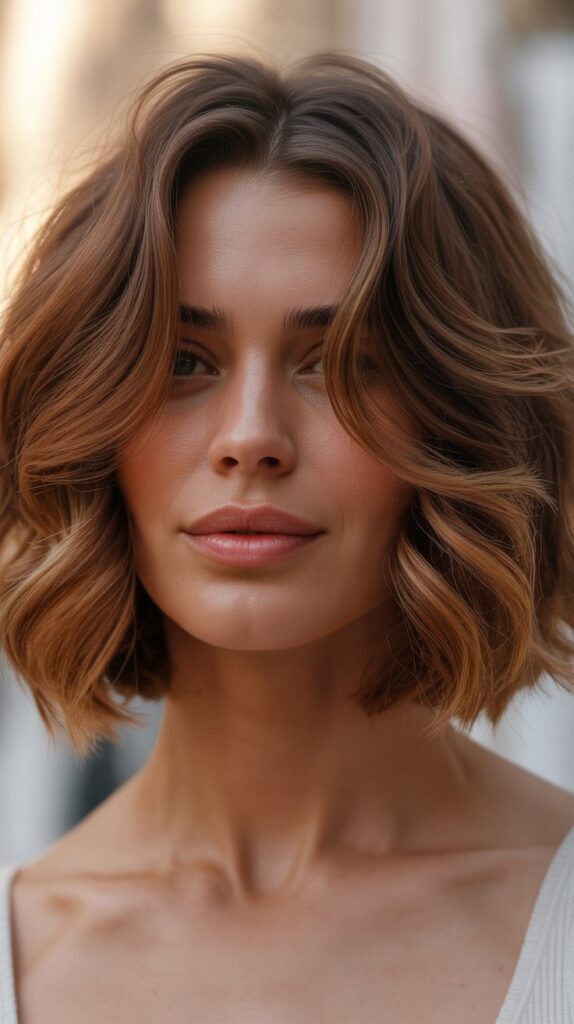
Soft, romantic waves combined with choppy layers create a feminine, approachable style.
This look is less edgy than beach waves and more polished.
Creating Soft Wave Patterns
- Use a large-barrel curling iron (1.5 inches or larger) for gentle curves.
- Curl all sections in the same direction for a more uniform wave pattern.
- Leave roots straight and start curling from mid-length down.
- Brush through the curls with a paddle brush to soften and blend.
- The choppy layers prevent the style from looking too perfect or beauty-pageant.
When to Choose This Style
- Soft waves are ideal for weddings, date nights, and special occasions.
- This styling approach works for professional settings that allow feminine looks.
- The combination of choppy cut and soft waves balances edgy and romantic.
- This is a good option if you prefer a more conservative, classic appearance.
- The style photographs beautifully and looks great from all angles.
19. Choppy Bob with Textured Fringe
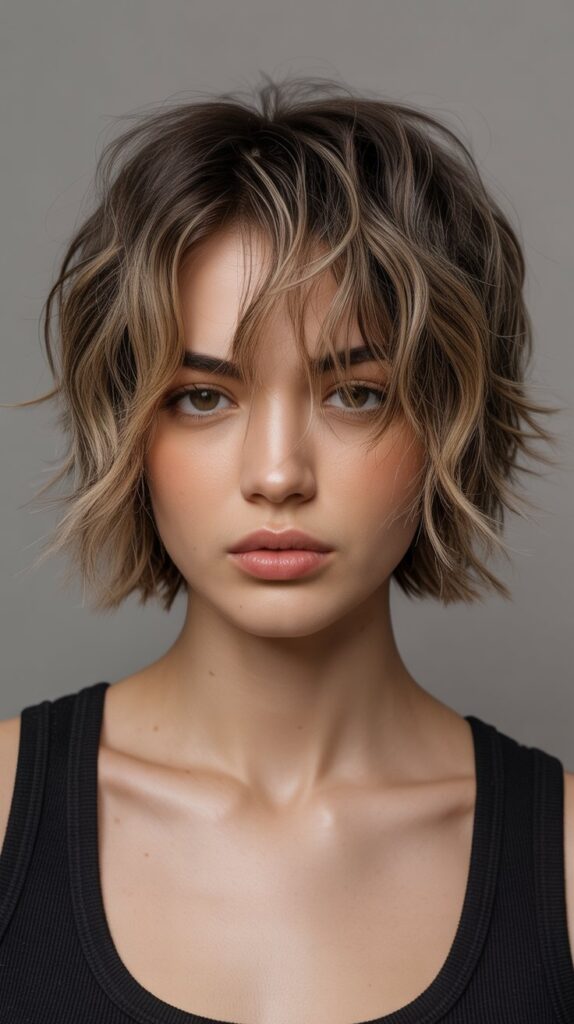
A textured fringe (bangs) adds personality to a choppy bob while helping to camouflage a larger forehead.
The fringe is cut with the same choppy technique as the rest of the hair.
Fringe Cutting Techniques
- The fringe is point-cut or razor-cut to create separation and texture.
- Piece-y sections are preferred over a solid, blunt fringe for fine hair.
- The fringe should be cut while hair is dry to ensure accuracy.
- Slightly longer pieces at the sides help blend the fringe with the rest of the bob.
- The texture prevents the fringe from looking too heavy or overwhelming fine hair.
Fringe Maintenance
- Trim the fringe every two to three weeks to maintain the length.
- Use a small round brush when blow-drying for control and shape.
- A straightening iron can smooth and separate pieces for definition.
- Dry shampoo on the fringe absorbs oil and adds texture between washes.
- Consider learning to trim your own fringe between salon visits for convenience.
20. Messy Choppy Bob with Side Part
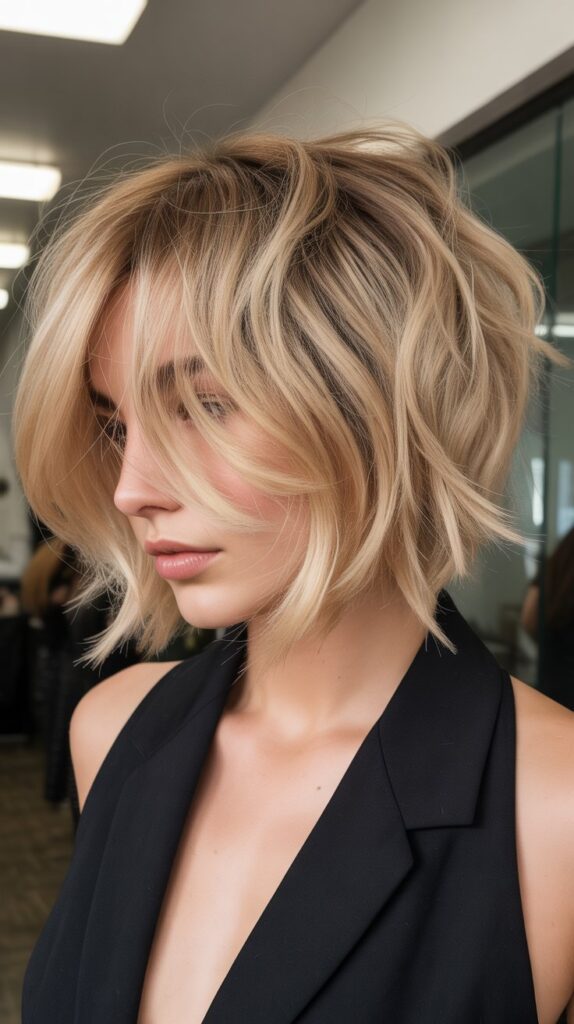
A deep side part combined with a messy choppy bob creates an asymmetrical look without committing to different lengths.
The side part adds instant volume on one side.
Creating the Perfect Side Part
- Part hair on the opposite side of your natural part for maximum volume.
- Use the arch of your eyebrow as a guide for where to place the part.
- Apply volumizing product at the roots on the heavier side before drying.
- Direct hair away from the part while blow-drying to create lift.
- The side part naturally creates asymmetry that complements the choppy texture.
Styling Tips
- The heavier side should be styled with more volume and body.
- The lighter side can be tucked behind the ear or kept smooth.
- This style works particularly well with the tousled, messy styling approach.
- Change up your part placement occasionally to prevent permanent hair training.
- A deep side part is more flattering for most face shapes than a center part.
21. Choppy Bob for Naturally Wavy Hair
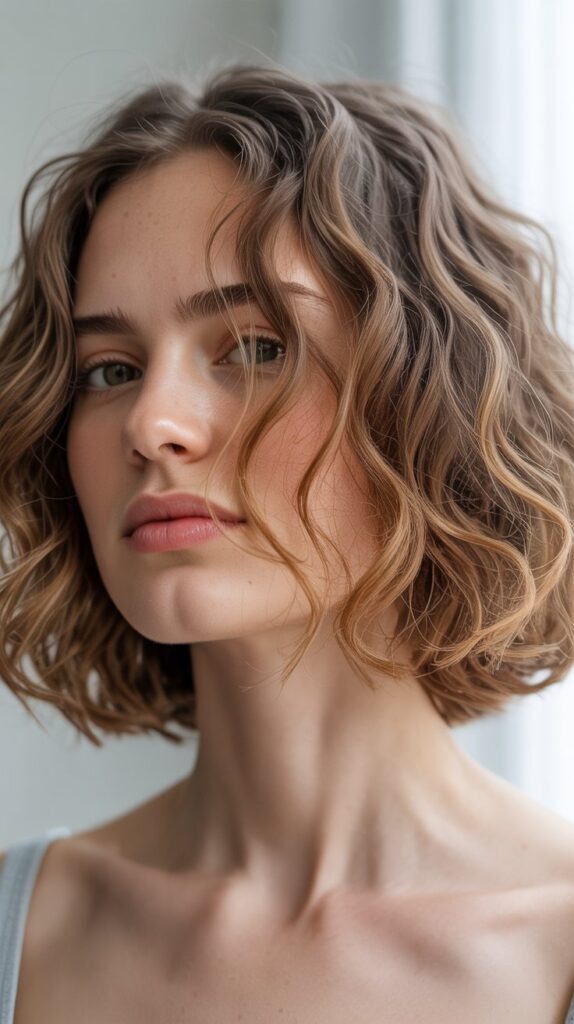
Those with naturally wavy fine hair can embrace their texture with a choppy bob that enhances rather than fights the natural pattern.
The cut removes weight that pulls waves straight.
Cutting for Wave Pattern
- The stylist should cut hair while dry to see how the waves naturally fall.
- Shorter choppy layers help waves spring up rather than being pulled down by weight.
- The cut should follow the natural wave pattern rather than working against it.
- Removing bulk from the ends allows the wave pattern to be more defined.
- Each wave section may need slightly different lengths to look cohesive.
Enhancing Natural Waves
- Apply a curl-enhancing cream or mousse to damp hair.
- Scrunch hair while air-drying or use a diffuser on low heat.
- Avoid brushing dry wavy hair, which causes frizz and disrupts the pattern.
- Use a wide-tooth comb or fingers to detangle when wet only.
- The choppy layers help define individual wave sections for better definition.
22. Choppy Bob with Blonde Ombré

A blonde ombré transitions from darker roots to lighter ends, creating dimension that enhances the choppy bob.
The color graduation makes fine hair appear thicker.
Ombré Technique for Choppy Bobs
- The darker roots should extend about one to two inches from the scalp.
- The transition to blonde happens gradually through the mid-lengths.
- The lightest blonde is concentrated on the choppy ends.
- This color placement emphasizes the textured layers and adds dimension.
- The dark roots eliminate the need for frequent touch-ups.
Color Maintenance
- Use a purple or blue toning shampoo to maintain cool blonde tones.
- Deep conditioning treatments are essential to maintain the health of lightened ends.
- Plan for a toner refresh every four to six weeks to prevent brassiness.
- The regrowth is intentional, so you can extend time between color appointments.
- Consider using Olaplex or similar bonding treatments to protect bleached hair.
23. Curly Choppy Bob for Volume
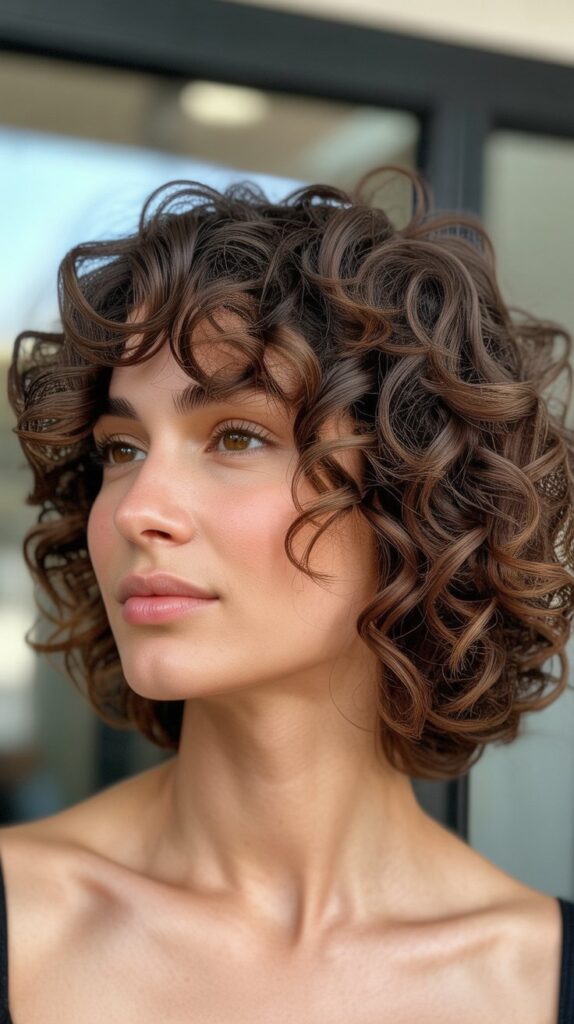
Fine hair with natural curl patterns benefits immensely from a choppy bob that removes weight and allows curls to spring free.
This cut prevents the “triangle” shape common with curly hair.
Cutting Curly Fine Hair
- The cut should always be done on dry, styled hair in its natural curl pattern.
- Curls should be cut individually based on how each one falls.
- The choppy layers help create a rounded shape rather than a pyramid.
- Remove weight from the bottom so curls at the crown have more volume.
- The bob length prevents curls from being weighed down by excessive length.
Styling Curly Choppy Bobs
- Apply a curl-defining cream to soaking wet hair in the shower.
- Scrunch hair with a microfiber towel or t-shirt to remove excess water.
- Apply a gel on top of the cream for curl hold and definition.
- Diffuse on low heat or allow to air-dry completely.
- Once dry, scrunch hair to break the gel cast and create soft, bouncy curls.
24. Choppy Bob with Money Pieces
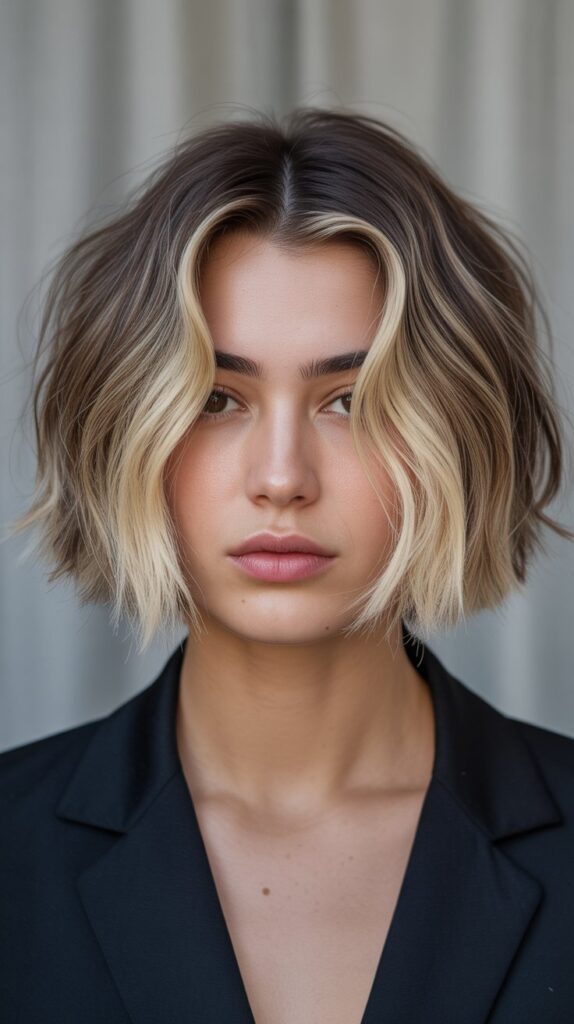
Money pieces are bright, face-framing highlights that instantly brighten your appearance.
Combined with a choppy bob, they create a fresh, modern look that requires minimal maintenance.
Money Piece Placement
- The highlights are placed in the two front sections that frame the face.
- They typically start at the root and extend through the entire length.
- The width should be about one to two inches on each side.
- Money pieces are usually two to three shades lighter than the base color.
- The bright highlights draw attention to your face and eyes.
Best Color Combinations
- Dark brown base with blonde money pieces creates high contrast.
- Medium brown with caramel money pieces offers a softer, sun-kissed look.
- Black base with dark brown or caramel money pieces provides subtle dimension.
- Red base with copper or golden money pieces enhances warmth.
- Blonde base with platinum money pieces adds brightness without harsh contrast.
25. Choppy Bob with Deep Side Sweep
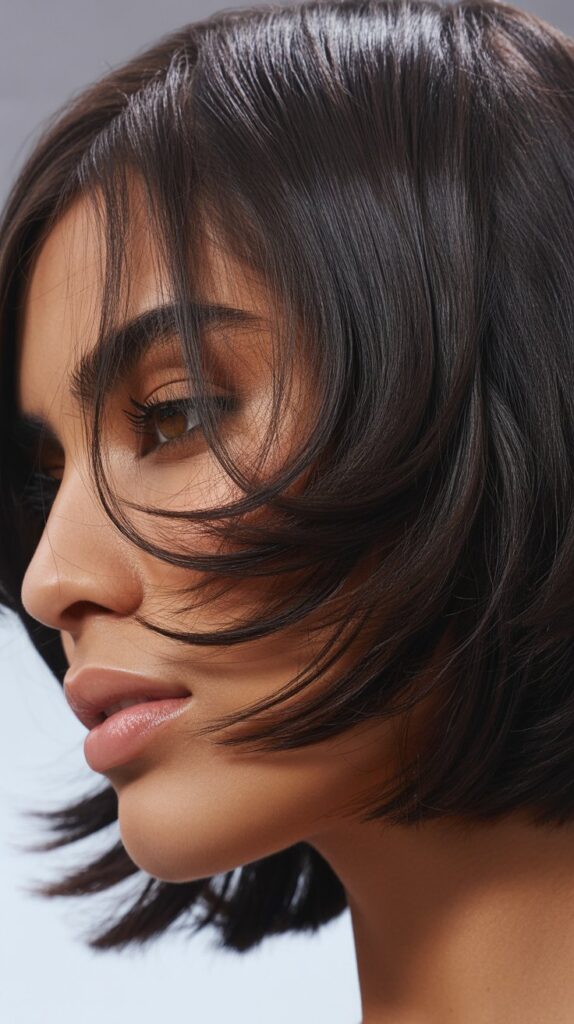
Styling a choppy bob with a deep side sweep creates old Hollywood glamour with modern texture.
The dramatic swooping movement across the forehead is elegant and eye-catching.
Creating the Side Sweep
- Apply a smoothing cream to damp hair for control.
- Create a deep side part, much further over than usual.
- Blow-dry using a paddle brush, directing hair across and over the forehead.
- Use a flat iron to smooth the swept section for a sleek finish.
- The choppy ends provide contrast to the smooth, swept top section.
Setting the Style
- Use bobby pins underneath the swept section to secure it in place.
- A medium-hold hairspray applied from underneath provides invisible hold.
- The sweep should curve naturally across the forehead, not lie flat.
- This style works best for special occasions or formal events.
- Remove pins and products at night to prevent hair breakage.
26. Stacked Choppy Bob with Nape Detail
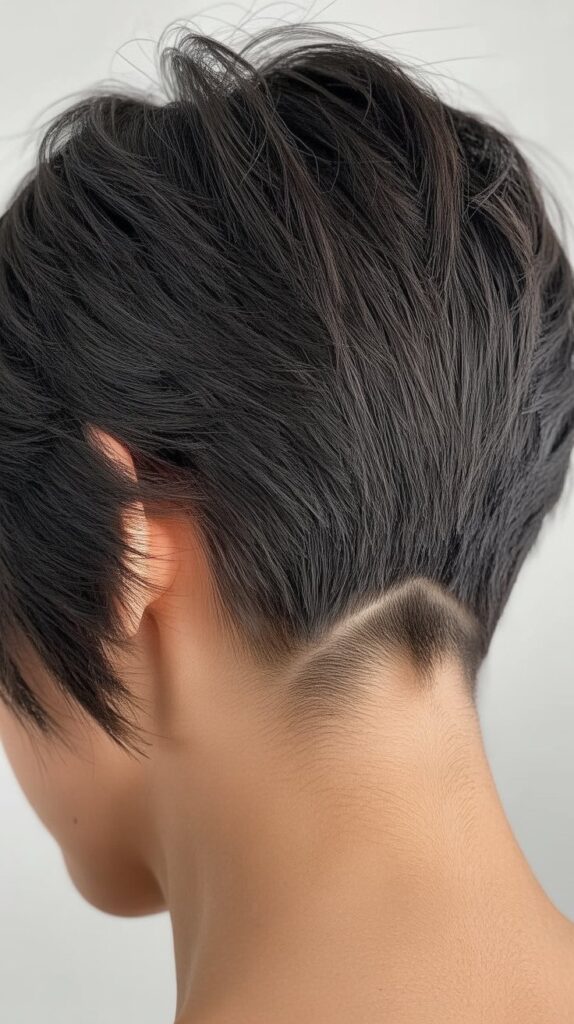
A stacked choppy bob features extreme graduation at the nape, creating a highly textured, voluminous back.
The nape detail can include patterns shaved into the undercut section.
Creating the Stack
- The back is cut in multiple layers, each one longer than the one below.
- The stacking typically starts at the occipital bone and builds upward.
- This technique can add one to two inches of height at the crown.
- The choppy texturing throughout prevents the stack from looking too structured.
- The nape can be buzzed, undercut, or layered depending on the desired effect.
Nape Detail Options
- A simple undercut removes weight and reduces styling time.
- Subtle geometric designs can be shaved into the nape for artistic flair.
- The nape hair can be left slightly longer and shaped into a V or U shape.
- Consider your professional environment before adding visible nape details.
- These details require maintenance every two to four weeks to stay sharp.
27. Choppy Bob with Highlights and Lowlights

Combining both highlights and lowlights creates maximum dimension in a choppy bob.
The multi-tonal color emphasizes every layer and creates depth that makes fine hair look fuller.
Color Strategy
- Start with your natural or desired base color as the foundation.
- Add highlights two to three shades lighter throughout the top layers.
- Place lowlights one to two shades darker in the underneath sections.
- The varying tones create shadow and light that emphasizes the choppy layers.
- This color technique works with any base color from black to blonde.
Application Method
- Balayage technique works best for a natural, blended appearance.
- Traditional foil highlights create more contrast and definition.
- The highlights should be concentrated where light naturally hits the hair.
- Lowlights add depth and prevent the color from looking flat or one-dimensional.
- Ask your colorist to customize the placement based on your specific cut.
28. Choppy Bob with Retro Vibes
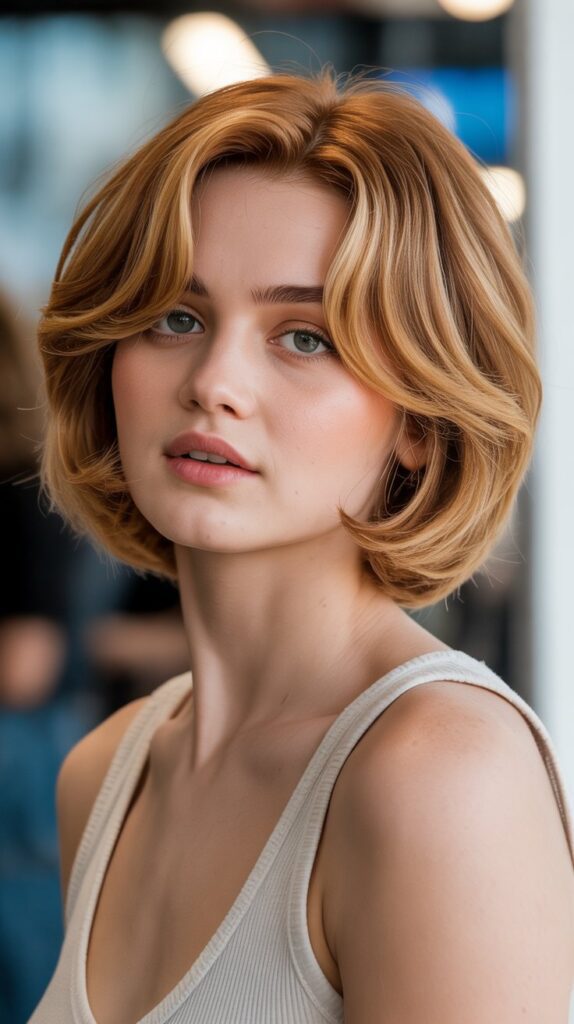
A retro-inspired choppy bob incorporates elements from the 1960s and 1970s, featuring shaggy layers and a vintage silhouette.
This nostalgic style feels fresh and modern when executed with contemporary techniques.
Vintage Elements
- The cut features shaggy layers throughout, reminiscent of iconic 1970s styles.
- The silhouette is slightly rounded rather than angular or geometric.
- Face-framing layers are prominent and frame the cheekbones.
- The ends can be flipped out or under for authentic retro styling.
- This cut often pairs beautifully with curtain bangs for a complete vintage look.
Modern Updates
- The choppy texturing technique is more refined than vintage shag cuts.
- Contemporary color techniques like balayage add modern dimension.
- The styling products used create texture without the stiffness of vintage hairspray.
- The cut maintains wearability for modern lifestyles while nodding to the past.
- This style has been popularized by celebrities embracing 70s-inspired looks.
29. Choppy Bob with Platinum Blonde
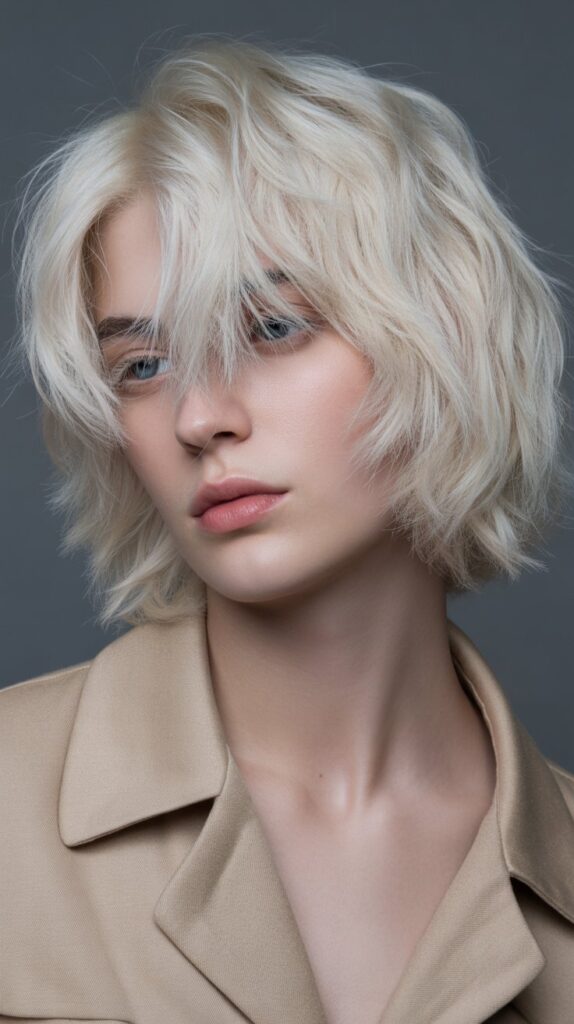
Platinum blonde coloring combined with a choppy bob creates an ultra-modern, high-fashion statement.
The bright color emphasizes every textured piece and layer.
Achieving Platinum Blonde
- This color requires professional bleaching, often multiple sessions for dark hair.
- The hair must be lightened to the palest yellow before toning to platinum.
- A purple or silver toner creates the cool, icy platinum shade.
- Fine hair is more vulnerable to damage during the bleaching process.
- Work with an experienced colorist who specializes in blonde color.
Maintaining Platinum
- Purple shampoo should be used at every wash to prevent yellowing.
- Deep conditioning treatments are essential twice weekly minimum.
- Olaplex or K18 treatments help rebuild bonds broken during bleaching.
- Touch-up appointments are needed every four to six weeks for root growth.
- Avoid chlorine, which can turn platinum blonde green or brassy.
- Use heat protectant religiously and minimize heat styling when possible.
30. Choppy Bob with Subtle Balayage

For those who want dimension without dramatic color change, subtle balayage on a choppy bob adds just enough interest.
The hand-painted highlights are only a shade or two different from the base.
Subtle Color Techniques
- The highlights should look like natural sun-lightening rather than deliberate coloring.
- Place the lightest pieces around the face and on the top layers.
- Keep the color change to one or two shades maximum for subtlety.
- The transition between base and highlighted sections should be seamless.
- This approach is ideal for conservative work environments or personal preference.
Benefits of Subtle Dimension
- The low-maintenance color requires fewer salon visits for touch-ups.
- The subtle dimension still enhances the choppy layers without being obvious.
- This approach is less damaging to fine hair than dramatic color changes.
- The natural-looking result flatters all ages and style preferences.
- It’s an excellent starting point if you’re nervous about color commitment.
31. Choppy Bob Styling Products Guide

Choosing the right products is crucial for maintaining and styling a choppy bob on fine hair.
Different products create different effects and textures.
Products to Avoid
- Heavy oils and serums that weigh down fine hair and make it look greasy.
- Thick, creamy styling products that are designed for coarse, thick hair.
- Aerosol hairsprays with high hold that make hair stiff and crunchy.
- Products with silicones that build up on fine hair over time.
- Leave-in conditioners applied to roots, which flatten the style.
32. Choppy Bob Maintenance and Care

Maintaining a choppy bob requires specific care routines to keep the cut looking fresh and the texture intact.
Regular maintenance is key to this style’s success.
Trim Schedule
- Schedule haircuts every four to six weeks to maintain the choppy shape.
- The textured ends can look ragged rather than intentional if left too long.
- Regular trims prevent split ends from traveling up the hair shaft.
- Between cuts, ask your stylist to refresh the texture even without removing length.
- Mark your calendar with appointments to stay consistent with maintenance.
At-Home Care Routine
- Use a sulfate-free shampoo formulated for fine hair to avoid weighing it down.
- Condition only the mid-lengths and ends, avoiding the roots entirely.
- Apply a weekly deep conditioning mask to prevent dryness and breakage.
- Sleep on a silk or satin pillowcase to reduce friction and preserve the style.
- Protect hair from sun damage with UV-protectant sprays or hats.
When to Refresh Your Cut
- If the layers no longer have distinct separation, it’s time for a trim.
- When styling takes significantly longer than usual, the cut needs refreshing.
- If you notice the shape looking unbalanced or growing out awkwardly, book an appointment.
- Split ends that are visible when hair is styled indicate the need for a trim.
- When you can no longer achieve the desired texture, the cut has grown out too much.
Conclusion
The 30+ best choppy bob haircuts for fine hair you’ll want to try this year offer incredible versatility, volume, and style for those with thin strands.
From classic textured bobs to modern asymmetrical cuts, each variation provides unique benefits that transform fine hair into a statement-making style.
The choppy layers create the illusion of thickness and fullness while requiring surprisingly low maintenance once you understand the right techniques and products.
Whether you prefer a subtle, professional look or a bold, edgy statement, there’s a choppy bob perfectly suited to your lifestyle and personality.
The key to success lies in finding a skilled stylist who understands how to cut fine hair, maintaining regular trims, and using the proper products that enhance rather than weigh down your texture.
With the right approach, a choppy bob can revolutionize your hair routine and give you the confident, voluminous style you’ve always wanted.
